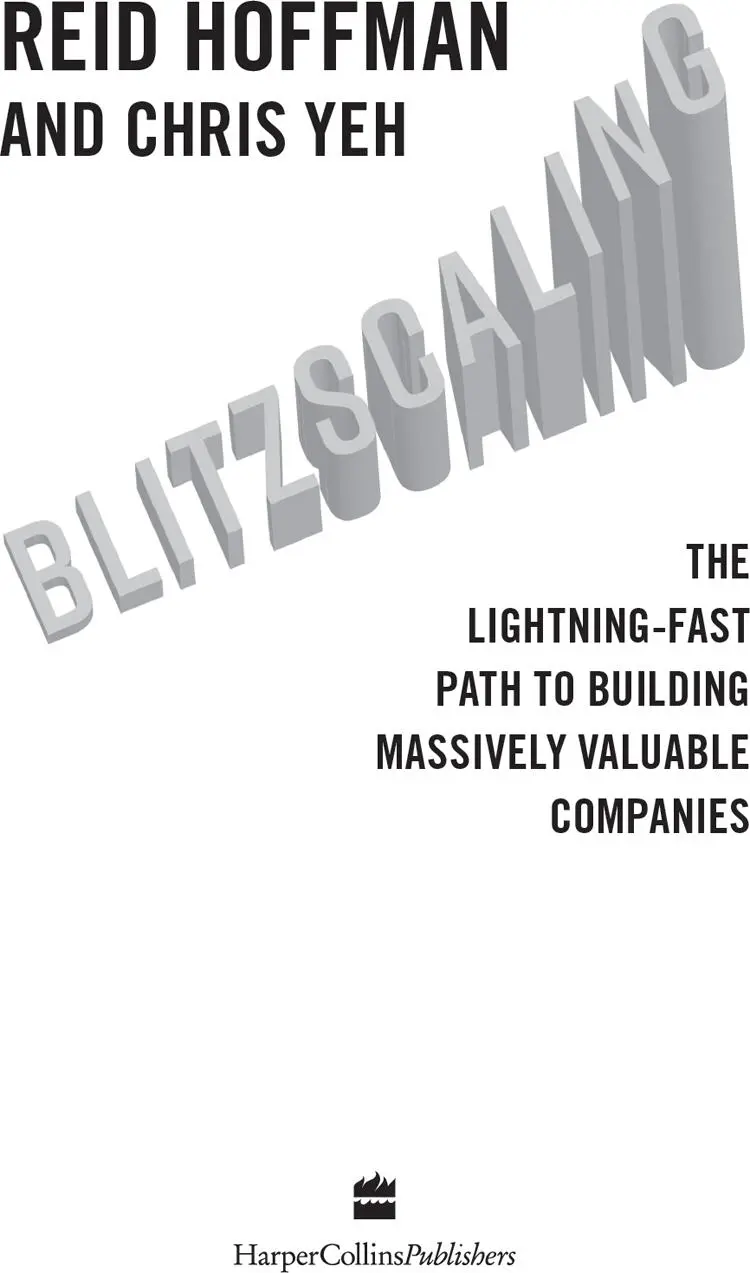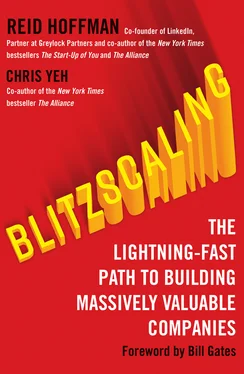
HarperCollins Publishers
1 London Bridge Street
London SE1 9GF
www.harpercollins.co.uk
First published in the US by Currency, an imprint of the Crown Publishing Group, a division of Penguin Random House LLC, New York
This UK edition published by HarperCollins Publishers 2018
FIRST EDITION
© Reid Hoffman and Chris Yeh 2018
Cover layout design © HarperCollins Publishers Ltd 2018
A catalogue record of this book is available from the British Library
Reid Hoffman and Chris Yeh assert the moral right to be identified as the authors of this work
All rights reserved under International and Pan-American Copyright Conventions. By payment of the required fees, you have been granted the nonexclusive, non-transferable right to access and read the text of this e-book on screen. No part of this text may be reproduced, transmitted, downloaded, decompiled, reverse engineered, or stored in or introduced into any information storage retrieval system, in any form or by any means, whether electronic or mechanical, now known or hereinafter invented, without the express written permission of HarperCollins e-books.
Find out about HarperCollins and the environment at www.harpercollins.co.uk/green
Source ISBN: 9780008303631
Ebook Edition © October 2018 ISBN: 9780008303655
Version 2018-09-10
Cover
Title Page
Copyright
Foreword by Bill Gates
Introduction
Part I: What Is Blitzscaling?
Software Is Eating (and Saving) the World
The Types of Scaling
The Three Basics of Blitzscaling
The Five Stages of Blitzscaling
The Three Key Techniques of Blitzscaling
Part II: Business Model Innovation
Designing to Maximize Growth: The Four Growth Factors
Designing to Maximize Growth: The Two Growth Limiters
Proven Business Model Patterns
The Underlying Principles of Business Model Innovation
Analyzing a Few Billion-Dollar Business Models
Part III: Strategy Innovation
When Should I Start to Blitzscale?
When Should I Stop Blitzscaling?
Can I Choose Not to Blitzscale?
Blitzscaling Is Iterative
How Blitzscaling Strategy Changes in Each Stage
How the Role of the Founder Changes in Each Stage
Part IV: Management Innovation
Eight Key Transitions
Nine Counterintuitive Rules of Blitzscaling
The Never-ending Need for Change
Part V: The Broader Landscape of Blitzscaling
Blitzscaling Beyond High Tech
Blitzscaling Within a Larger Organization
Blitzscaling Beyond Business
Blitzscaling in Greater Silicon Valley
Other Blitzscaling Regions to Watch
China: The Land of Blitzscaling
Defending Against Blitzscaling
Part VI: Responsible Blitzscaling
Blitzscaling in Society
Framework for Responsible Blitzscaling
The Response Spectrum
Balancing Responsibility and Velocity as the Organization Grows
Conclusion
Acknowledgments
Appendix A: Disclosures
Appendix B: The Blitzscalers
Appendix C: CS183C Essays
List of Searchable Terms
About the Authors
Back Ad
About the Publisher
I’ve known Reid Hoffman for years. Our friendship started on my visits to Silicon Valley to meet with Greylock Partners, the venture capital firm where Reid is a partner, so I could learn about the companies they were investing in. I was always impressed by his sharp mind and brilliant business sense. Reid is famous for hosting long dinners where the conversation runs late into the night, and we’ve spent many meals breaking down the technology industry, analyzing the promise of artificial intelligence, and more. When Microsoft CEO Satya Nadella started talking about acquiring LinkedIn, I knew it would be an amazing fit.
Of all the things I’ve discussed with Reid, the most thought-provoking might be blitzscaling. It is an idea that applies to many different industries, as he and Chris explain in the last section of this book. But prioritizing speed over efficiency—even in the face of uncertainty—is especially important when your business model depends on having lots of members and getting feedback from them. If you get in early and start getting that feedback and your competitors don’t, then you’re on the path to success. In any business where scale really matters, getting in early and doing it fast can make the difference.
This is especially true for two-sided business models, where you have two user groups that create positive network effects for each other. For example, LinkedIn wants to attract people who are looking for work as well as employers who want to hire them. Airbnb wants guests looking for a place to stay as well as hosts with space to rent. Uber wants to attract drivers as well as riders.
And a software company with an operating system to sell wants app developers as well as end users. Microsoft definitely went through a blitzscaling phase (although we didn’t call it that at the time). We got on the learning curve early and were able to build a reputation as a serious company. We had an extreme culture of working hard and getting things done fast.
The ideas behind blitzscaling aren’t just for startups and scale-ups. They’re important for big, established companies too. The window for action can be tiny and it can close quickly. Even a few months of hesitation can mean the difference between leading and chasing.
Reid and Chris’s ideas are more practical than ever, because it is now possible to get big fast in a way that simply wasn’t feasible a few decades ago. There is a rich ecosystem of service providers and outsourcing companies to support rapid growth. Many companies have gone through their own big growth spurts, so there are lots of examples to learn from. User feedback comes in a constant stream of data. Product cycles have dropped from yearly to weekly or daily. And good reviews can spread in an instant online, so a strong product can quickly attract a big audience.
In other words, the case studies you’re about to explore and the tools you’re about to gain have never been more relevant. This is an ideal moment to be reading this book. I’m glad Reid and Chris are sharing their insights.
2011: SAN FRANCISCO, AIRBNB HEADQUARTERS
“They’re probably going to kill you.”
The year was 2011, and in the offices of Airbnb, then a scrappy little forty-person start-up, its cofounder and CEO Brian Chesky had just received some very bad news.
Brian pondered the implications of the ominous prediction he’d just heard from Andrew Mason, the cofounder and CEO of Groupon. He didn’t like it.
Brian and his cofounders, Joe Gebbia and Nathan Blecharcyzk, had already fought their way through plenty of obstacles to build Airbnb, a website that makes it easy for people to rent out their rooms or homes for the night. In the beginning, every investor the founders approached had turned them down or, worse, ignored them. The company was on the upswing now, but the painful early days were still fresh in their minds, and they weren’t looking for another battle.
Читать дальше













